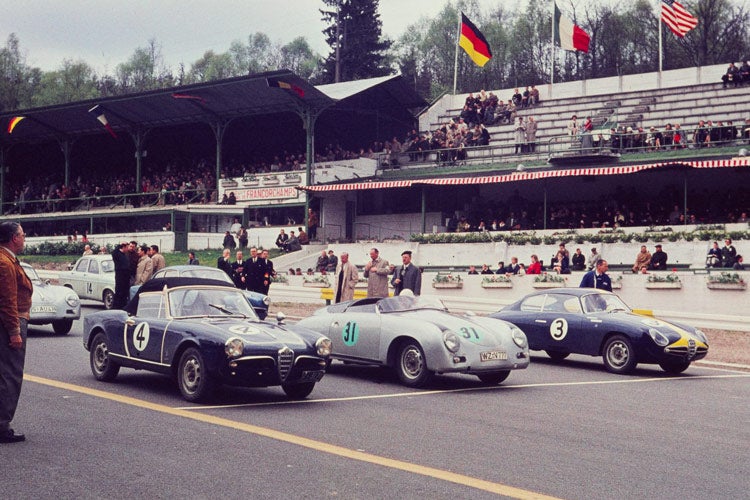|
September 5, 2014
Stanford's new Revs Digital Library spotlights the automobile as cultural icon
Stanford's new Revs Digital Library provides access to hundreds of thousands of images related to the history of auto racing and the cultural significance of the automobile. The website expands research opportunities for scholars and students. By Clifton B. Parker

Grand Prix de Spa Grand Touring Race, 1959. A digital trove of images of automobiles, auto racing and car culture provides a rich resource for designers, engineers and cultural scholars. (Photo: Courtesy Revs Institute for Automotive Research)
Stanford University's new Revs Digital Library provides a web-based tour through the world of the automobile – its past, present and future.
The digital trove is a Stanford University Libraries project for the Revs Program on campus. The new content comes from the Revs Institute for Automotive Research in Naples, Florida. Thanks to a gift from Revs Institute president Miles Collier, Stanford Libraries recently launched the online site, which includes nearly 200,000 images from 12 collections.
New image collections will be added as they are received, digitized and processed, said Gabrielle Karampelas, the director of communications and development for Stanford University Libraries. The content will be stored in the Stanford Digital Repository.
Launched in 2011, the Revs Program is a multidisciplinary center dedicated to the study of cars.
Collier said that when his organization looked for a partner to develop a digital library site, they soon discovered that Stanford Libraries was the best choice.
"Stanford's digital map project and their work in documenting the development of Silicon Valley were projects we looked to as emblematic of the Stanford University Libraries' ability to help us achieve our goals," he said.
'Amazing material'
Christina Ann Mesa, a Stanford lecturer in American studies, found the new library invaluable for her undergraduate course, On the Road: Cars and Auto-Mobility of Race, Gender and Age in American Literature, a class sponsored by the Revs Program. That class was followed up by a workshop for students who were interested in doing more car research for a book. The initial work has now morphed into four different writing projects.
"Students were tasked with finding out more about how the car changed American history, culture, society and landscape," Mesa said. "Stanford has the great fortune of having the project of digitizing this amazing material."
Mesa said the car is the single most important invention of the 20th century, as it transformed the landscape, cities and even culture of America.
Her course explored numerous topics and images, from motoring in London at the dawn of the 20th century to women drivers and a '20s Bentley photo for F. Scott Fitzgerald's Great Gatsby novel. But there's much more – Mesa described the archive as immense.
"It will take time to get it all up. I think that is the biggest task. I'd love to see more students having a hand in the archival work – a great research opportunity that allows students from all disciplines to interact," she said.
"The students enjoyed the interdisciplinary work," she said of the course.
For her research, Mesa and her students found information on car names and colors from the 1940s and advertisements from every decade, as well as descriptions of the licensing as far back as the 1840s of horse-drawn hackney carriages, the precursor to motorcar licensing.
Mesa learned through the Revs Institute about a digital copy of the Negro Motorist Green Book, which was a guidebook for African Americans to find the gas stations that would serve them in the Jim Crow era, when many gas stations did not serve African Americans.
"That this guide existed was news to me. What a discovery," she said.
Innovation, experimentation
Robert Schwarzwalder, associate university librarian and director of library technologies at Stanford, said the new site will help faculty and student researchers in a broad range of research interests in areas such as social and urban studies, design and engineering.
"The early 1900s was a time of rapid innovation and experimentation in the fledgling automotive industry," said Schwarzwalder. "Just as during the dot-com era of Silicon Valley, this was a period of radical new ideas and rapid technical innovation."
Schwarzwalder said the biggest challenge in creating the online site was providing access to the materials in a manner that provided maximum user access while complying with the complexities of copyright law as it relates to digital materials.
Hearst Publishing Corp. recently transferred its entire archive of Road & Track magazine to Stanford University Libraries, which will preserve and digitize the collection for future research.
-30-
|